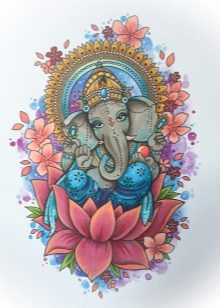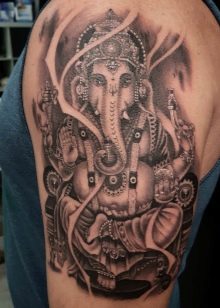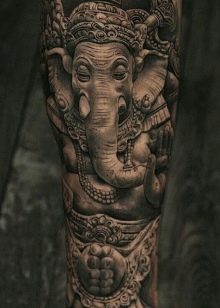Tattoo "Ganesha": sketches and meaning
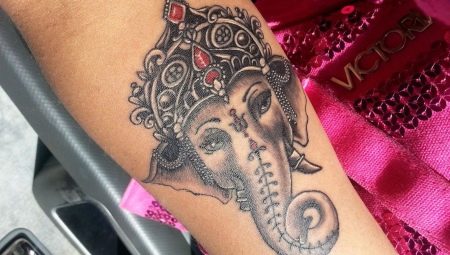
Exotic and unusual tattoos are now very popular. Such drawings on the body indicate a person's passion for any culture or his desire for self-improvement. One of these tattoos is an image of an Indian deity named Ganesha.
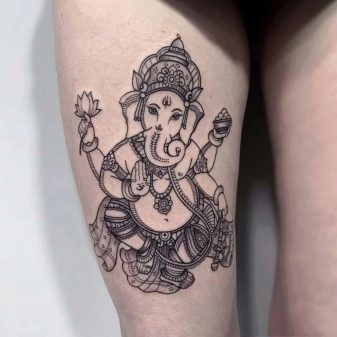
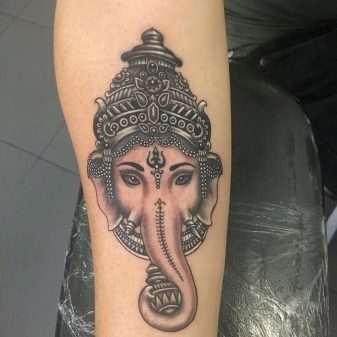
The meaning of a tattoo
Ganesha tattoo has a very rich history. The image represents a god with an elephant's head and a human body. The deity is one of the most revered in Indian culture.
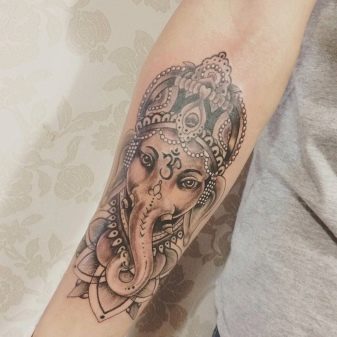
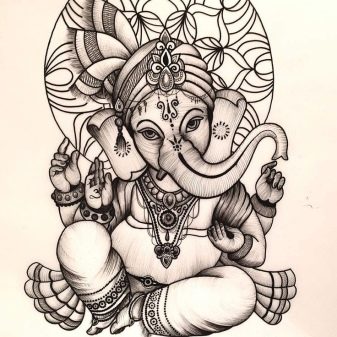
Ganesha is the son of the god Shiva and his wife Parvati. Initially, he looked like an ordinary child. According to one theory, the god Shani, at the celebration in honor of the birth of a baby, accidentally turned the child's head into ashes. After that, Shiva decided to replace the human head with an elephant one. But there is another theory, according to which Shiva himself tore off the head of his son in a fit of rage. When his wife began to grieve over what had happened, God decided to rectify the situation. He attached the head of an elephant to the boy's body.

The Indian deity is considered supportive and merciful. He is treated with great respect. Ganesha is usually depicted with an elephant's head and a large belly. The number of the deity's hands ranges from four to eight. It is not by chance that Ganesha is portrayed in this form. Each part of his body has a special meaning.
-
Ears. Huge elephant ears symbolize the deity's ability to listen to the wishes of ordinary people.
-
Tusks. Sharp tusks are a symbol of power and strength.
-
Trunk. Ganesha's long, twisted trunk is a symbol of his high intellectual abilities.
-
Stomach. The Indian god is usually depicted as full. The deity's huge belly symbolizes his generosity.

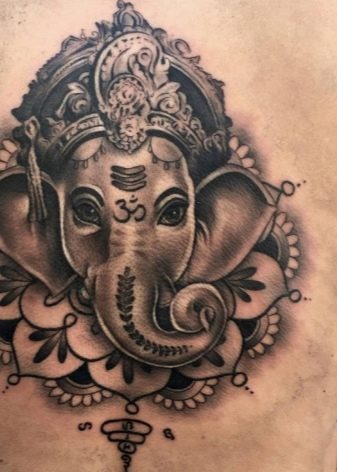
Ganesha tattoo is popular among both women and men.The deity is considered the master of success.
Therefore, many believe that a tattoo with his image will bring good luck and material well-being to a person. Indian deity tattoos are ideal for people doing creative work.
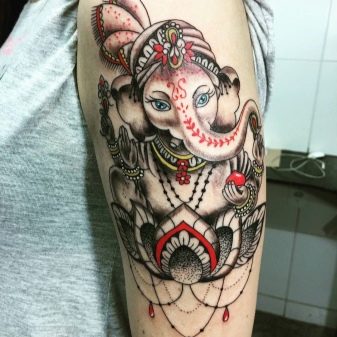
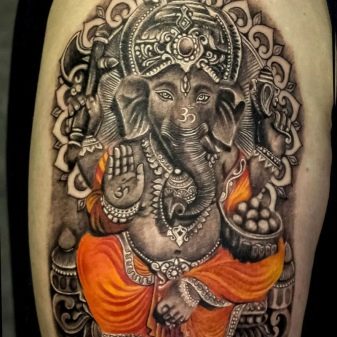
Sketch ideas
There are many interesting sketches depicting Ganesha. The image of this Indian deity is often supplemented with various details. This makes the tattoo more unique and original.
-
Lotus. A tattoo with a delicate flower will look especially beautiful on a woman's body. This plant is a symbol of harmony with oneself and the surrounding world. This tattoo looks great in a watercolor style. The lotus that adorns the base of the tattoo can be pink, purple or green.
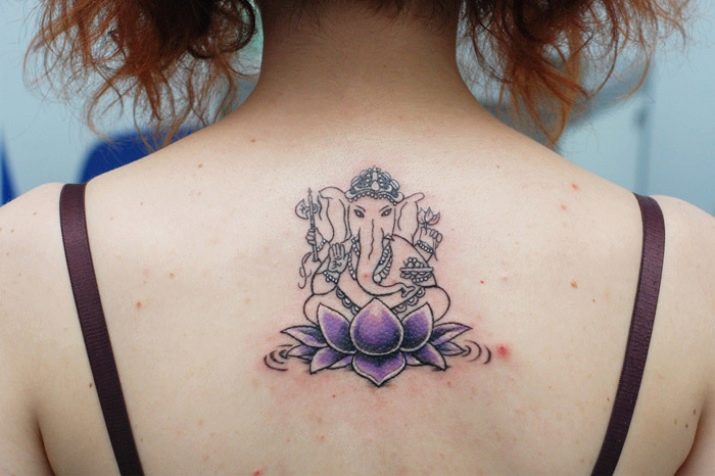
- Sweets. A tattoo depicting sweets and other offerings symbolizes abundance and well-being.

- Mantra. Om is a sacred symbol in Hinduism. A tattoo depicting Ganesha can be supplemented with a graphic image. She is a symbol of development and movement forward.
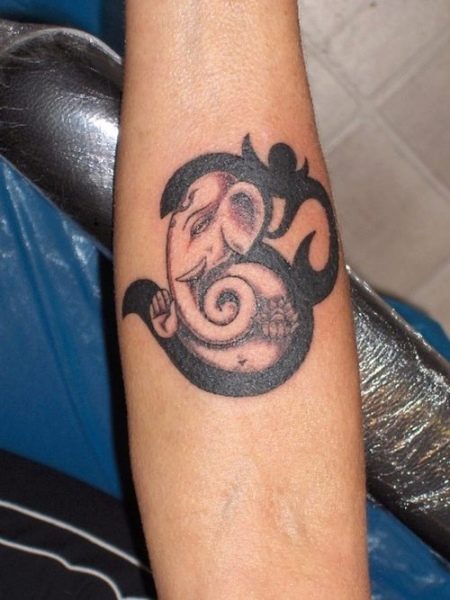
- Axe. The mighty Ganesha is often depicted with a small ax in his hands. Such a tattoo personifies perseverance and desire to fight against obstacles. As a rule, such drawings are chosen by men.
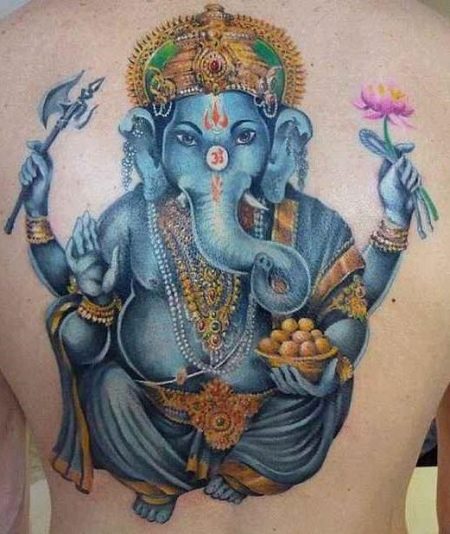
- Nimbus. A tattoo depicting a deity with a halo over his head emphasizes the holiness of Ganesha.
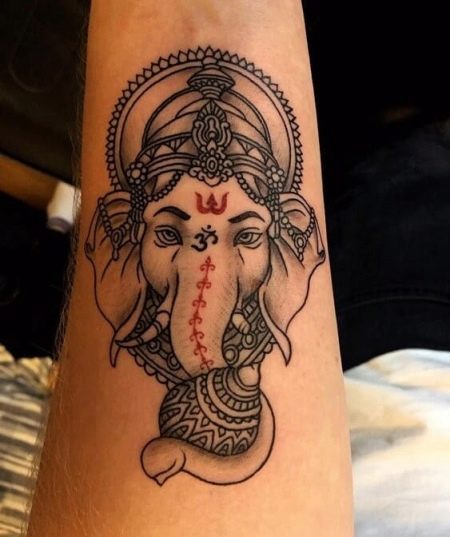
In the hands of an Indian god, there may also be a staff, a trident, or even a snake conquered by him.
Styles
Tattoos with the image of Ganesha can be either monochromatic or multi-colored. There are several of the most popular stylistic trends that fans of this art form should pay attention to.
-
Blackwork. Dark blackwork tattoos are often used to overlap older artwork. Such drawings look interesting and unusual. They will appeal to fans of strict and restrained tattoos.
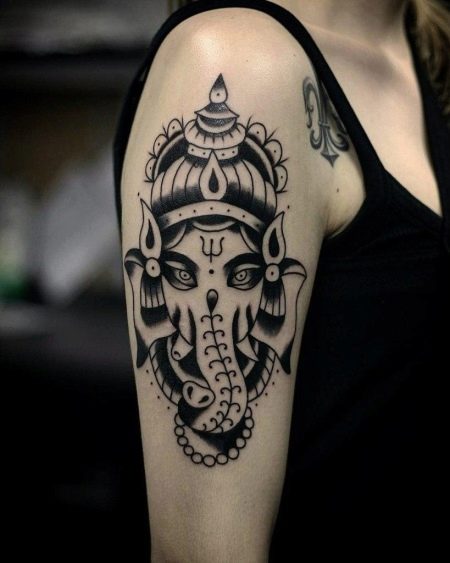
- Realism. Volumetric realistic tattoos are most often stuffed on the back. Such a drawing can be supplemented with thematic patterns and images of stones. The process of creating such tattoos usually takes a long time. But the result is worth it, because the drawings are effective and "vivid". In addition, they do not fade over time and also do not blur.
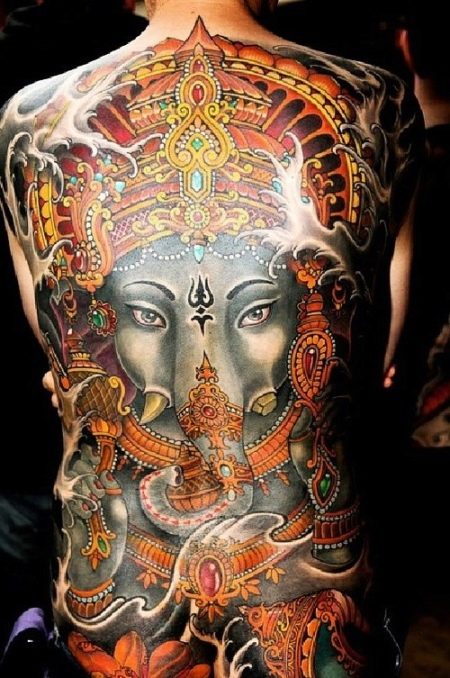
- Watercolor. Bright watercolor tattoos also deserve special attention. Ganesha is usually painted in blue. The base of the tattoo is complemented by purple and pink strokes. Girls and women are especially fond of watercolors.

- Dotwork. Small black dot tattoos are the exact opposite of vibrant watercolor designs. Lovers of minimalism like these tattoos. They look great on hands and feet.

When choosing a style, you should focus not on fashion and the opinions of others, but on your own preferences.
Where can you apply?
A tattoo depicting the god Ganesha will suit both a guy and a girl. You can place a volumetric pattern on different parts of the body.
-
Hands. Men often get a tattoo on their shoulder or forearm. A correctly selected drawing will emphasize the developed muscles and will always look beautiful, as well as tattoos that occupy an area of the body from the wrist to the elbow.
-
Back. There is enough room on the back for a large drawing. Volumetric tattoos with a lot of details look great there. As a rule, such drawings are stuffed next to the neck. Colored tattoos that take up the entire back also look spectacular.
-
Legs. Volumetric tattoos with a deity are most often stuffed on the lower leg or front of the thigh. Such designs are sometimes complemented with mandalas, oriental patterns or flowers.
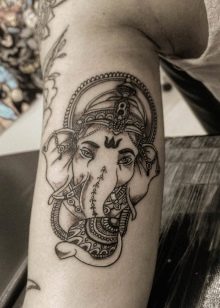

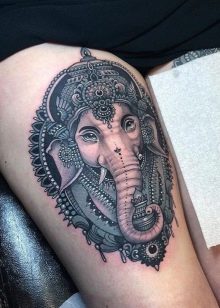
Small tattoos depicting this god look beautiful between the collarbones or above the lower back.
A unique tattoo depicting Ganesha will bring happiness and well-being to the life of its owner. The main thing is to take care of her correctly, and to treat the chosen drawing with love.
